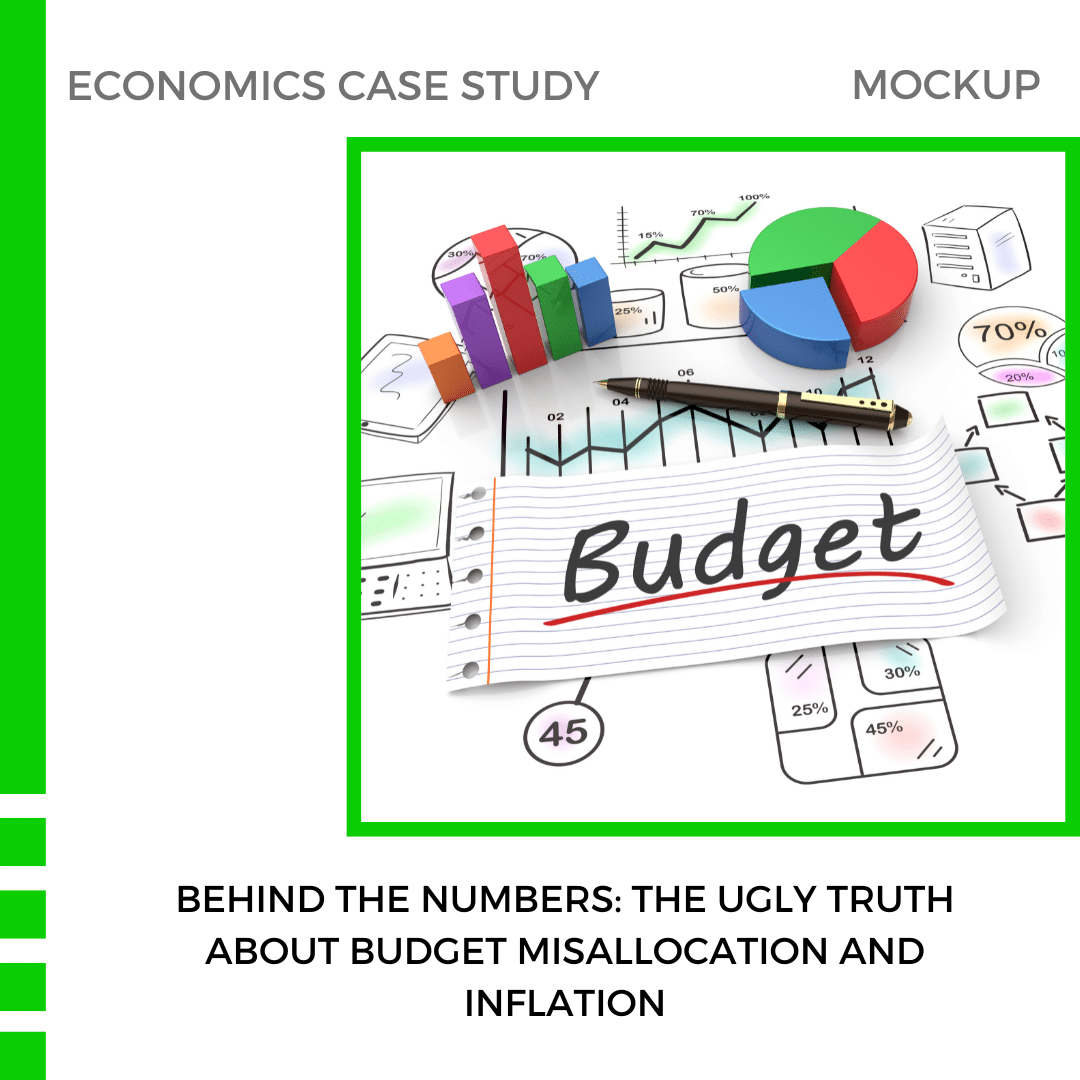
Behind the Numbers: The Ugly Truth About Budget Misallocation and Inflation
Introduction
This case study examines how a misallocated government budget can disrupt economic stability, focusing on the Fast-Moving Consumer Goods (FMCG) sector. Misjudgments in budget allocation can distort market dynamics, create artificial demand, and increase inflation. The government of the fictional country Econoland has used its budget to provide subsidies and incentives to specific industries. However, these interventions have unintentionally caused price inflation and supply chain disruptions, leaving consumers and producers struggling with volatile markets.
Students are challenged to analyze the root causes of inflation, explore the relationship between budget allocations and market performance, and propose solutions to balance economic growth with price stability. The goal is to better understand how government spending decisions can impact consumer welfare, businesses, and overall economic efficiency.
Background of the Misallocation
Overview of Government Budget Allocation
In Econoland, a significant portion of the government’s budget is allocated to sectors such as agriculture and manufacturing to promote economic growth and job creation. However, political considerations, lobbying, and poor targeting have led to inefficient resource use, creating distortions in the economy. The FMCG sector is particularly affected, as subsidies to support production inadvertently generate excess demand for consumer products.
Impact on the FMCG Sector
The subsidies create an illusion of affordability, driving consumers to purchase more goods. The result is a surge in demand for essential products like food, beverages, and household supplies. However, this demand is artificial and not reflective of real market needs, leading to production imbalances and price hikes.
Key Events Leading to Inflation
Government Subsidies
The government provides generous subsidies to domestic agricultural producers to boost food security. However, these subsidies are not targeted effectively, leading to waste and inefficiencies. Some producers benefit disproportionately, while others remain underfunded, skewing supply-and-demand dynamics in the FMCG sector.
Manufacturing Incentives
The government offers tax breaks and incentives to companies to stimulate manufacturing growth and encourage expansion. However, overproduction in some industries leads to price inflation, as supply chains struggle to keep pace with sudden increases in demand for finished goods.
Consumer Behavior
Consumers react to lower prices by over-purchasing FMCG products, believing they are getting bargains. This behaviour exacerbates the demand surge, further straining supply chains and triggering shortages and stockouts. The rising costs erode the purchasing power of lower-income households, forcing them to spend more on basic necessities.
Immediate Impact on Econoland
Price Inflation
The artificially created demand causes price inflation in the FMCG sector, as producers raise prices to manage rising production costs and distribution bottlenecks. Essential items become increasingly unaffordable for vulnerable consumers, contributing to public frustration.
Supply Chain Disruptions
The supply chain cannot keep pace with the sudden spike in demand. Stockouts and logistical challenges emerge, disrupting the availability of goods. Manufacturers face production delays, while retailers struggle to maintain adequate inventory levels.
Economic Distortions
Misallocations in the government budget affect market efficiency, creating barriers to entry for small businesses. Firms that do not receive subsidies find competing difficult, leading to reduced innovation and market stagnation.
Strategic Challenges
Corrective Measures
- Reforming Subsidy Programs: The government must overhaul its subsidy policies to improve their targeting. Programs should be aligned with economic needs and sustainable development goals.
- Encouraging Market Competition: Promoting healthy competition in the FMCG sector can reduce inflationary pressures and foster innovation. Fair competition helps ensure that all producers—subsidized or not—compete on a level playing field.
- Enhancing Consumer Awareness: Public campaigns educating consumers on the real cost of subsidized goods can help reduce overconsumption and stabilize prices. Responsible consumption habits will reduce demand volatility.
Tasks for Students
- Inflation Analysis: Examine how government subsidies and incentives have driven inflation in the FMCG sector.
- Stakeholder Analysis: Identify key stakeholders affected by inflation, including government agencies, manufacturers, retailers, and consumers.
- Policy Recommendations: Develop actionable recommendations to reform subsidy programs and manage consumer behaviour effectively.
- Long-Term Strategy: Propose a sustainable long-term strategy for ensuring price stability while promoting economic growth in Econoland.
Possible Solution
One possible solution for Econoland is to adopt a Balanced Budget Framework, which focuses on responsible allocation and regular assessment of spending programs. Key elements of this solution include:
- Performance-Based Subsidies: Linking subsidies to performance metrics, such as environmental sustainability or production efficiency, to ensure alignment with broader policy objectives.
- Flexible Budgeting: Implementing flexible budgeting practices that allow for reallocation based on real-time market conditions, helping to prevent inflation and overspending.
- Public Accountability: Introducing transparent monitoring systems and third-party audits to assess the impact of subsidies. Learn more about budget transparency initiatives from the International Monetary Fund (IMF).
This framework ensures that subsidies promote sustainable growth without distorting market dynamics, stabilizing the economy over the long term.
Conclusion
The misallocation of the government budget in Econoland highlights the unintended consequences of poorly designed subsidy programs. Although subsidies can stimulate growth, their misuse can create artificial demand, distort market dynamics, and trigger inflation. Addressing these challenges requires targeted policy reforms, enhanced market competition, and consumer education initiatives.
By adopting a Balanced Budget Framework, Econoland can align its spending with real economic needs, stabilize prices, and restore competitiveness in the FMCG sector. This case study emphasizes the importance of prudent budget management and offers valuable insights into how government policies affect market performance and public welfare.
Explore Business Models of Global Companies and Indian Companies
Tag:balanced budget framework, budget, case studies, case study, consumer behavior, economic distortions, economic growth, economics case study, FMCG sector, government budget misallocation, inflation, mockup case study, price inflation, public accountability, subsidies and incentives, supply chain disruptions, sustainable policy



